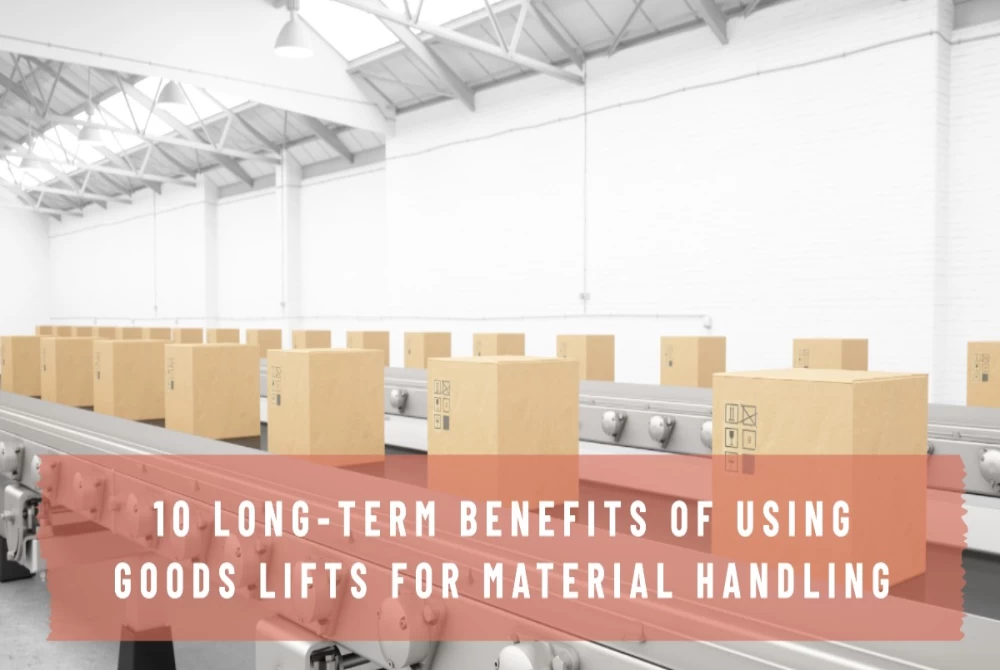
- Published 17 January, 2025
10 Long-Term Benefits of Using Goods Lifts for Material Handling - Geevok Official Blog
Goods lifts are an important part of material handling systems in warehouses, factories, and large buildings. They help move heavy items quickly and safely between different floors.
Below are 10 ways shared by one of the best goods lift manufacturers in India they save money in the long run
Reduced Labor Costs
- Goods lifts reduce the need for manual labor.
- Instead of workers carrying heavy materials, the lift does the job.
- Fewer workers are needed for lifting and transporting items.
- This leads to savings on salaries and wages.
- Businesses can reduce staff or reassign them to other tasks.
- Labor costs are lower because fewer people are required.
- The lift can work continuously without breaks, unlike humans.
- This helps companies save money in the long term.
Decreased Risk of Injury
- Lifting heavy items by hand can cause serious injuries.
- Workers may hurt their backs, arms, or legs.
- Using a goods lift eliminates the need for manual lifting.
- The lift moves heavy items safely, reducing injury risk.
- With fewer injuries, there are fewer medical bills.
- Workers can avoid long recovery times.
- The company spends less on workers' compensation.
- They provide a safer environment for employees.
- A safer workplace leads to fewer accidents overall.
Increased Productivity
- They speed up material handling.
- Workers do not need to spend time carrying heavy items.
- They can focus on other important tasks.
- The lift works quickly, moving materials between floors.
- This reduces delays and keeps work flowing smoothly.
- Workers are less tired because they don’t lift heavy loads.
- With more time for other tasks, productivity increases.
Lower Equipment Wear-and-Tear
- They handle the heavy lifting, reducing strain on other equipment.
- Forklifts, cranes, and manual tools don’t have to carry heavy loads.
- Less stress on these tools means they last longer.
- With fewer repairs needed, maintenance costs go down.
- Equipment will not break as often because it’s not overused.
- Businesses can avoid costly replacements of damaged tools.
- They take on the tough jobs, preserving the condition of other equipment.
- This reduces the need for frequent maintenance checks.
- The company saves money on repair parts and labor.
Space Efficiency
- They help use vertical space in buildings.
- Instead of using floor space for moving materials, lifts go up and down.
- This saves valuable ground space for storage or work areas.
- Businesses can store more materials in the same area.
- With these, items can be moved between floors without taking up extra space.
- It’s easier to organize materials and equipment.
- Companies don’t need extra large areas for transport, which reduces costs.
Reduced Need for Additional Storage
- They can move materials directly to upper floors.
- This means businesses do not need extra storage on the ground floor.
- Items can be stored in higher areas, saving space on lower levels.
- With a lift, businesses can use vertical space for storage.
- This helps keep the workplace organized and efficient.
- It reduces the need to rent or build more storage areas.
- Fewer storage spaces mean lower costs for the business.
- Materials are moved quickly to where they are needed.
- Just like Home elevators in Delhi, they ensure that space is used in the most effective way.
Lower Insurance Costs
- They reduce the risk of accidents in the workplace.
- Fewer injuries mean fewer insurance claims.
- Businesses can avoid high medical bills and compensation costs.
- With fewer accidents, insurance companies may offer lower premiums.
- The safer the workplace, the less the company must pay for insurance.
- They protect workers by handling heavy loads safely.
- Insurance costs become more affordable as risks decrease.
- A safer environment leads to long-term savings on insurance.
Less Need for External Contractors
- They can move heavy materials without needing extra help.
- This reduces the need to hire contractors for lifting and transporting.
- External workers are often needed for manual handling tasks.
- By using a lift, businesses save on outsourcing costs.
- The lift works automatically, saving time and money.
- Businesses no longer need to pay for temporary workers.
- They handle material movement, so contractors are not required.
Longer Equipment Life
- They are designed for heavy use and can last a long time.
- They are built to handle tough tasks like moving heavy materials.
- Since goods lifts do the heavy lifting, other equipment is not overworked.
- This helps other tools last longer and reduces wear-and-tear.
- Businesses do not need to replace equipment as often.
- They are reliable and durable, reducing the need for repairs.
- With less strain on machines, the equipment stays in good condition.
- This saves money on repairs and replacements.
- Over time, the investment in a goods lift pays off.
Energy Efficiency
- Modern goods lifts are designed to use less power.
- They are energy-efficient, which reduces electricity costs.
- They consume less energy compared to cranes or forklifts.
- This helps lower the business's overall energy bills.
- Energy-efficient lifts have motors and systems that use less power.
- With lower energy use, companies can save money in the long run.
- These lifts are also more environmentally friendly.
- Using less power reduces the carbon footprint of the business.
